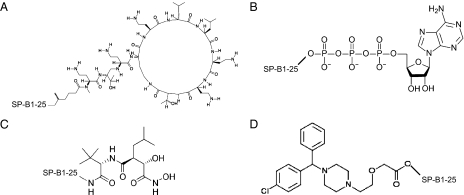Fig. 3.
Proposed SP-B1-25–linked therapeutics for other lung ailments. Polymyxins disrupt Gram-negative bacterial membranes and are highly effective even against multidrug-resistant strains, but they have not been widely used because of toxicity concerns. Covalent linkage of a polymyxin to a surfactant peptide fragment (A) can be used to isolate this compound to the lungs and thus potentially minimize or circumvent systemic toxicity. Activating a purinergic receptor requires ATP or an ATP analog. The purinergic P2Y receptor may be targeted to treat cystic fibrosis, and the P2X receptor may be targeted to treat latent tuberculosis. Covalent linkage of ATP to the surfactant peptide (B) may enhance the efficacy of both protocols. Shutting down the EGF family of pathways by stopping cell-surface EGF ligand shedding is a promising new lung cancer strategy. This can be accomplished by inhibiting the ADAM metalloproteinases, but no inhibitor of this class of enzymes has ever successfully passed clinical trials. A strategy of isolating such an inhibitor to the lungs via surfactant linkage (C) may circumvent the pervasive toxicity problems with these types of compounds. A long-duration, infrequent dosing antihistamine (D) may be created with a surfactant-linked strategy.

